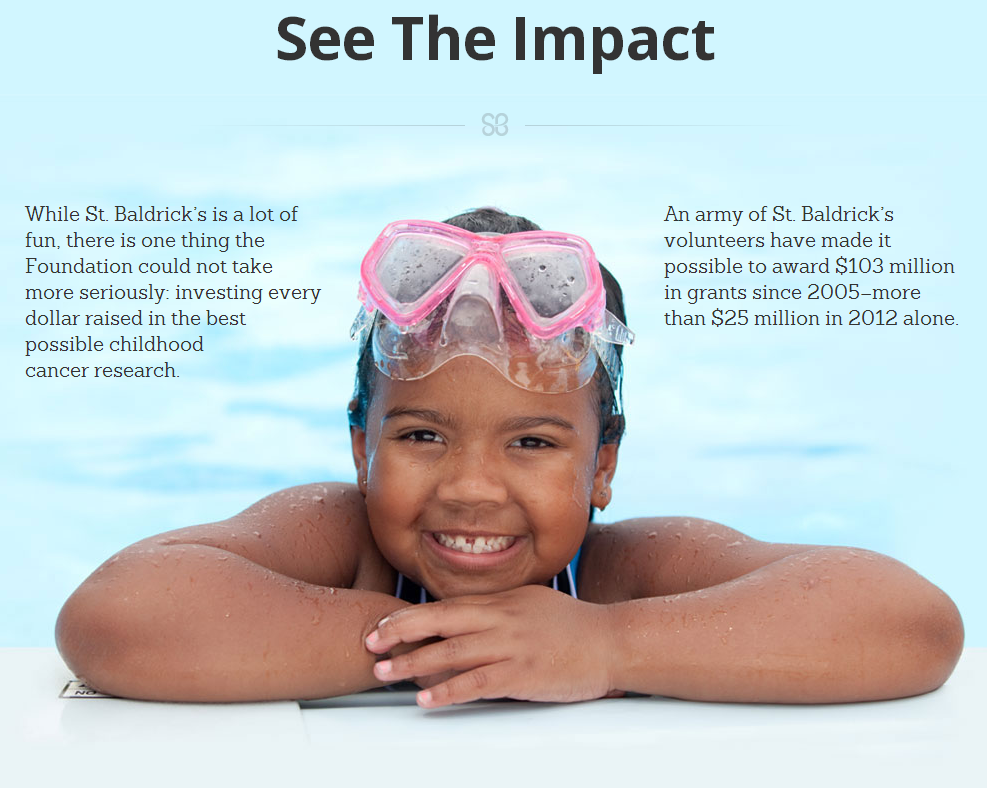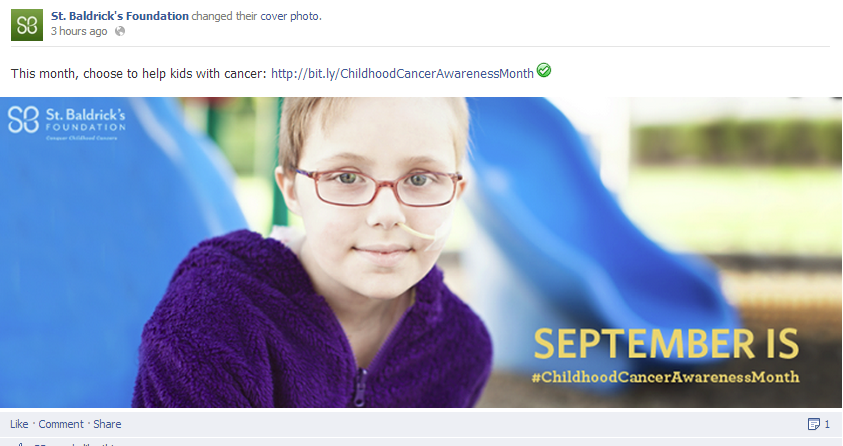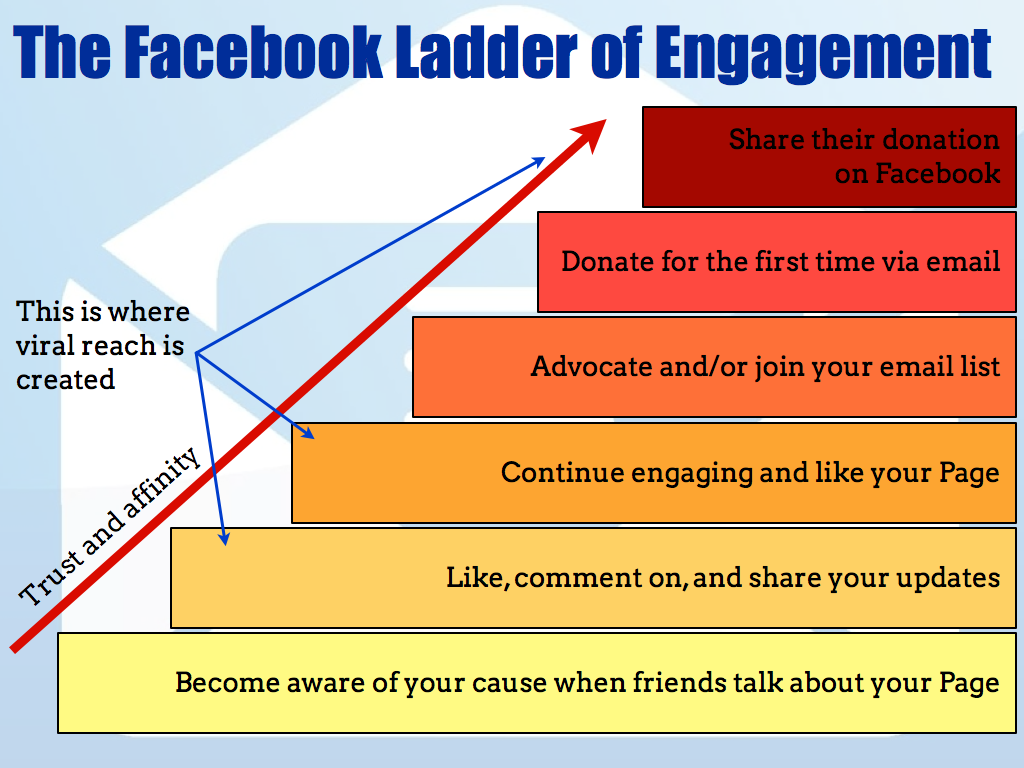 Case Study: How One Nonprofit Raised Thousands Using Facebook – Part 2
Case Study: How One Nonprofit Raised Thousands Using Facebook – Part 2
This is the second part in my two part case study of the St. Baldrick’s Foundation, a volunteer-driven charity that effectively uses social media tools to raise money and engage supporters. Read part one here.
In Tuesday’s post, I covered 8 ways that the St. Baldrick’s Foundation uses social media to raise thousands of dollars and engage thousands of supporters.
In today’s post, I will discuss how they use Online Brand Ambassadors and free tools offered to nonprofits by Google, as well as their future plans and their advice for small nonprofits struggling to build a community on social media.
1) Understand the Facebook Ladder of Engagement.
The reason that St. Baldrick’s has invested so much time in Facebook is due to its social and interactive nature.
Facebook provides the organization with a real-time opportunity to engage with the general public, listen to conversations and field questions.
The casual and less formal nature of Facebook works in their favor.
“Facebook is great because we can engage with our community without them feeling like they have to commit or become an advocate in that moment,” said Natalie Stamer, St. Baldrick’s Director of Digital Communication Strategy.
The organization found that they were often producing PSA videos, email newsletters and content on the website that usually had an ultimatum attached – either click away feeling guilty or donate right now!
Enter the Facebook Ladder of Engagement. Think of all Facebook interactions like dating.
When a potential supporter first learns about St. Baldrick’s, they are not likely to donate on the spot, or to sign up to shave their head.
Supporters need to be wooed, they need to be educated, they need to be inspired and most of all, they need to know that an organization is legitimate and will be a good steward for their time and their money.
Gradual engagement is key – using social media tools, show potential supports who you are and what you do, prove your legitimacy as a nonprofit and show that you will be responsible with the funds that you are receiving.
Most importantly, show that you are making a difference, rather than constantly asking for donations, event registrations or volunteers.
2) Utilize Online Brand Ambassadors.
St. Baldrick’s has several groups of Online Brand Ambassadors, one of the most important being their participants – the intrepid do-gooders who offer to shave their head in order to raise money for the charity.
Stamer says that these participants are absolutely crucial in getting the word out about St. Baldrick’s – using social media channels, the head-shavers post their stories and their photos about why they are shaving their heads, and they raise a lot of the money online. (I mean, who wouldn’t want to see a friend or relative shave their head, and who wouldn’t be compelled to make a donation as a tribute to that level of commitment?)
In the past, the education and resources for participants were passive – emails and other resources that participants can download and use at their discretion.
This year St. Baldrick’s is changing this to a more active training of participants – there will be webinars where they can sign in and learn more about how to use Facebook and Twitter in their fundraising efforts.
Their Online Brand Ambassadors also get a specific email series that shares different tips about fundraising and how to use each online platform effectively.
Facebook generates 50% of all St. Baldrick’s Foundation website traffic – and a huge percentage of that is generated by the participants and Ambassadors, who are out there posting, tweeting and sharing every single day.
3) Face-to-face asks will always be the most powerful and effective form of fundraising.
Despite the success the organization has had with Facebook, they do not suggest that their Online Brand Ambassadors and their supporters use it to the exclusion of other fundraising methods.
Stamer wisely cautions that Facebook should only be used passively for fundraising, as the percentage of people who donate directly through the social network is much lower than a direct email ask or a face-to-face ask.
“Facebook is most effective when the participants share their stories and their photos, when they update their friends on their progress and when they educate and inform their friends about the cause,” Stamer said.
After and during all the educating, inspiring and informing, follow up with a face-to-face ask or a direct email and experience much higher success.
4) Grow your audience.
There are several ways that St. Baldrick’s consistently grows their social media audience:
a) Using email. Stamer uses email to communicate directly with participants and donors, to ask them to like the organization on Facebook and follow on Twitter and to directly request that they spread the word about the great work of the charity via social networks.
b) Let people know you are on social media. St. Baldrick’s does this with prominent social media buttons on the homepage of their website.
c) Use Facebook integration. They have a Facebook Like integrated throughout the site.
d) Let people spread the word. They have incorporated the Facebook Like and Share capabilities into the donation confirmation page so that people can share that they just made a donation. People love to share when they are doing good! This is a fantastic way to get in front of supporters’ friends and family who may not know about the organization.
5) Get a Google AdWords Grant.
Google offers a full suite of free tools to nonprofit organization.
St. Baldrick’s uses one of these nonprofit perks, a Google AdWords Grant, to drive tons of traffic to their website and Facebook page.
This one Google Grant resulted in 19,489 clicks in the first third of 2013.
Stamer estimates the lifetime value of the free grant to be $1 million, because it resulted 17 event registrations, 641 participant registrations and 1227 donations.
6) Prioritize.
I asked Stamer how her organization prioritizes the time spent on social networks and how they came to put the most emphasis on Facebook.
The answer: Figure out what works and do more of it.
Use measurement tools and data collection to inform the organization’s choices of where to focus.
Each month Stamer and her team look at the data and see which posts on which networks were most successful, which were least successful and what happened in terms of their conversion goals. Did people donate? Did people sign up for the email newsletter? Did they sign up to be advocates or participants?
Keep posting, tweeting, tracking, analyzing and seeing what is working and what is not.
(For more on measurement, make sure to read Measuring the Networked Nonprofit by Beth Kanter and Katie Paine.)
7) Advice for small nonprofits using social media?
I posed this question to Stamer: “What is most important thing that small nonprofits with small budgets should be doing on social media?”
Follow the St. Baldrick’s philophy – always listen to your audience first.
Listen first, then engage. Engagement on behalf of the organization is key!
Engagement doesn’t mean posting the same information on five social networks and then logging off.
“This is where many organizations get it wrong,” said Stamer. “It is ‘social’ media after all – so many people miss the ‘social’!”
Two other smart pieces of advice: a) Always stay true to your brand and b) always direct social media visitors back to your website.
Future Plans
In terms of St. Baldrick’s future social media plans, there are many!
The charity aims to focus more on Twitter and Instagram, as well as exploring posting more frequently on Google+.
Stamer says that right now the organization tends to post the same content in multiple places, whereas a goal for 2013/2014 is to tailor the content more to each specific platform and each audience. (Smart!)
More great plans are in the works, and I look forward to detailing them in future posts.
Please leave me your thoughts and questions in the comments section.



Comments 41
NEW POST –> How One Nonprofit Raised Thousands Using Facebook – Part 2 http://t.co/8P1ym85jrl
RT @JuliaCSocial: NEW POST –> How One Nonprofit Raised Thousands Using Facebook – Part 2 http://t.co/8P1ym85jrl
How One Nonprofit Is Raising Thousands Using Facebook – Part 2 http://t.co/dRn5cRo5X8 via @JuliaCSocial
RT @shane_barker: How One Nonprofit Is Raising Thousands Using Facebook – Part 2 http://t.co/dRn5cRo5X8 via @JuliaCSocial
How One Nonprofit Is Raising Thousands Using Facebook – Part 2 http://t.co/nmliXBYLYD via @JuliaCSocial
How One Nonprofit Is Raising Thousands Using Facebook – Part 2 http://t.co/SUsTOUvRK9 via @JuliaCSocial RT @douglasi
How One Nonprofit Is Raising Thousands Using Facebook – Part 2 http://t.co/KqM7d3MYqe via @JuliaCSocial RT @douglasi
RT @douglasi: How One Nonprofit Is Raising Thousands Using Facebook – Part 2 http://t.co/EaWKi6IqNj via @JuliaCSocial
How One Nonprofit Is Raising Thousands Using Facebook – Part 2 http://t.co/NvQ2rJFKZv via @JuliaCSocial
RT @MoreInMedia: How One Nonprofit Is Raising Thousands Using Facebook – Part 2 http://t.co/NvQ2rJFKZv via @JuliaCSocial
Already know FB #fundraising basics? Then there’s part 2: by @JuliaCSocial w/ #SocialMedia success story @StBaldricks http://t.co/Ym4mc7ETDK
RT @MoreInMedia: How One Nonprofit Is Raising Thousands Using Facebook – Part 2 http://t.co/NvQ2rJFKZv via @JuliaCSocial
RT @MoreInMedia: How One Nonprofit Is Raising Thousands Using Facebook – Part 2 http://t.co/NvQ2rJFKZv via @JuliaCSocial
RT @inot4profit: Already know FB #fundraising basics? Then there’s part 2: by @JuliaCSocial w/ #SocialMedia success story @StBaldricks http…
How One Nonprofit Is Raising Thousands Using Facebook – Part 2 – http://t.co/8u7bvHwogo via @JuliaCSocial @StBaldricks #hcsm
RT @teaminspire: How One Nonprofit Is Raising Thousands Using Facebook – Part 2 – http://t.co/8u7bvHwogo via @JuliaCSocial @StBaldricks #hc…
How One Nonprofit Is Raising Thousands Using Facebook – Part 2 http://t.co/E6fEyfyh3M via @JuliaCSocial
How One Nonprofit Is Raising Thousands Using Facebook – Part 2 http://t.co/71lmk1WRtC via @JuliaCSocial
How One Nonprofit Is Raising Thousands Using Facebook – Part 2 http://t.co/cuO5HAxJTX via @JuliaCSocial
How One Nonprofit Is Raising Thousands Using Facebook – Part 2 http://t.co/FPQEpByjkp via @JuliaCSocial
RT @MelissaOnline: How One Nonprofit Is Raising Thousands Using Facebook – Part 2 http://t.co/FPQEpByjkp via @JuliaCSocial
RT @MelissaOnline: How One Nonprofit Is Raising Thousands Using Facebook – Part 2 http://t.co/FPQEpByjkp via @JuliaCSocial
How One Nonprofit Is Raising Thousands Using Facebook – Part 2 http://t.co/7mI2fgqxxY via @JuliaCSocial
How One Nonprofit Is Raising Thousands Using Facebook – Part 2 http://t.co/hmdRfVas26 via @JuliaCSocial
RT @JohnCBader: How One Nonprofit Is Raising Thousands Using Facebook – Part 2 http://t.co/7mI2fgqxxY via @JuliaCSocial
How One Nonprofit Is Raising Thousands Using Facebook – Part 2 http://t.co/dhIIMkgxhW via @JuliaCSocial
How One Nonprofit Is Raising Thousands Using Facebook – Part 2 http://t.co/U79NLtXaXX via @JuliaCSocial
J Campbell Social Marketing How One Nonprofit Is Raising Thousands Using Facebook http://t.co/ydigHW8osc @RichardGEarl
How One Nonprofit Is Raising Thousands Using Facebook – Part 2 http://t.co/hQLXYMPfYe via @JuliaCSocial
RT @leaderswest: How One Nonprofit Is Raising Thousands Using Facebook – Part 2 http://t.co/hQLXYMPfYe via @JuliaCSocial
How One Nonprofit Is Raising Thousands Using Facebook – Part 2 http://t.co/1z8h8FgSus RT @leaderswest via @JuliaCSocial
How One Nonprofit Is Raising Thousands Using Facebook – Part 2 http://t.co/YngzBNVHPb
How One Nonprofit Is Raising Thousands Using Facebook – Part 2 http://t.co/AwAkLY9wdl via @JuliaCSocial
RT @MeghanMBiro: How One Nonprofit Is Raising Thousands Using Facebook – Part 2 http://t.co/AwAkLY9wdl via @JuliaCSocial
RT @MeghanMBiro: How One Nonprofit Is Raising Thousands Using Facebook – Part 2 http://t.co/AwAkLY9wdl via @JuliaCSocial
RT @MeghanMBiro: How One Nonprofit Is Raising Thousands Using Facebook – Part 2 http://t.co/AwAkLY9wdl via @JuliaCSocial
How One Nonprofit Is Raising Thousands Using Facebook – Part 2 http://t.co/Hv0dchrJdq via @JuliaCSocial @MeghanMBiro
How One Nonprofit Is Raising Thousands Using Facebook – Part 2 http://t.co/8BAV3bHmIX via @JuliaCSocial
How One Nonprofit Is Raising Thousands Using Facebook http://t.co/llGmBPu23p via @zite
How One Nonprofit Is Raising Thousands Using Facebook – Part 2 http://t.co/6RVgsD92JX via @JuliaCSocial
Pingback: How One Nonprofit Is Raising Thousands Using Facebook (via Julia Campbell) – 8 Secrets to Social Media Success | iNotForProfit